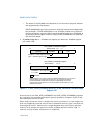
11-38 Vol. 3
MEMORY CACHE CONTROL
Before attempting to access these SMRR registers, software must test bit 11 in the
IA32_MTRRCAP register. If SMRR is not supported, reads from or writes to registers
cause general-protection exceptions.
When the valid flag in the IA32_SMRR_PHYSMASK MSR is 1, accesses to the specified
address range are treated as follows:
• If the logical processor is in SMM, accesses uses the memory type in the
IA32_SMRR_PHYSBASE MSR.
• If the logical processor is not in SMM, write accesses are ignored and read
accesses return a fixed value for each byte. The uncacheable memory type (UC)
is used in this case.
The above items apply even if the address range specified overlaps with a range
specified by the MTRRs.
11.11.3 Example Base and Mask Calculations
The examples in this section apply to processors that support a maximum physical
address size of 36 bits. The base and mask values entered in variable-range MTRR
pairs are 24-bit values that the processor extends to 36-bits.
For example, to enter a base address of 2 MBytes (200000H) in the
IA32_MTRR_PHYSBASE3 register, the 12 least-significant bits are truncated and the
value 000200H is entered in the PhysBase field. The same operation must be
performed on mask values. For example, to map the address range from 200000H to
Figure 11-8. IA32_SMRR_PHYSBASE and IA32_SMRR_PHYSMASK SMRR Pair
V — Valid
PhysMask — Sets range mask
IA32_SMRR_PHYSMASK Register
63
0
Reserved
101112
V
Reserved
31
PhysMask
Type — Memory type for range
PhysBase — Base address of range
IA32_SMRR_PHYSBASE Register
63
0
Reserved
1112
Type
31
PhysBase
78
Reserved


















